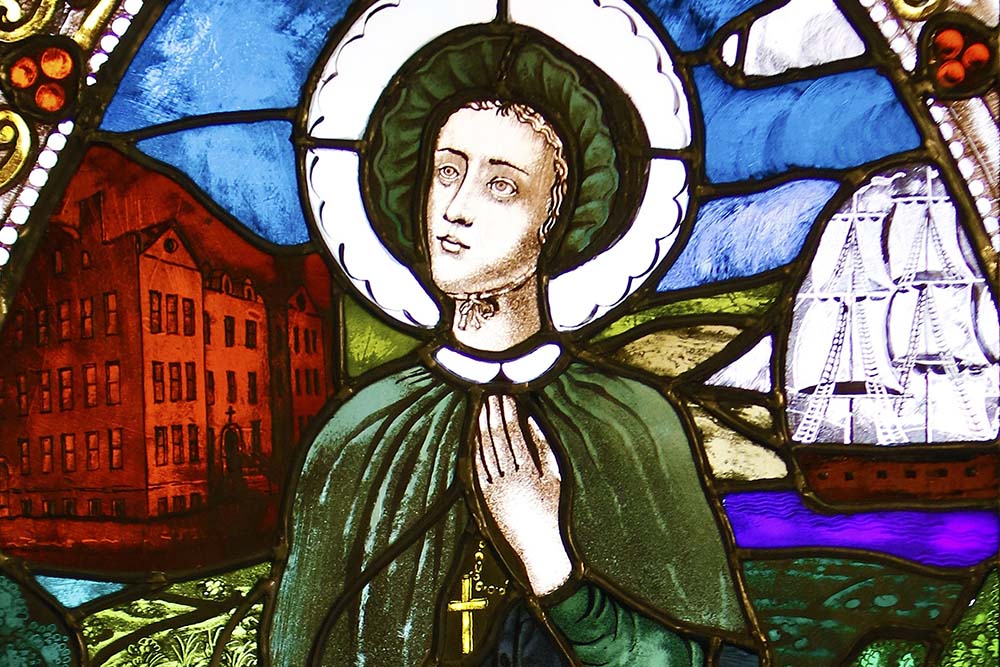
St. Elizabeth Ann Seton is depicted in a stained-glass window at the Basilica of St. Patrick's Old Cathedral in New York City. (CNS/Gregory A. Shemitz)
American religious sisters have been central protagonists in the larger narrative of women's history, but that record has often been eclipsed, according to scholars during a recent panel discussion on American and Italian Catholic identities.
"Sisters' history has not been integrated in a meaningful way into the relevant areas of women's history because doing so requires acknowledging different paths," said Elisabetta Vezzosi, director of the humanities department of the University of Trieste in Italy.
"Sisters were on the forefront of the American efforts to provide women with education, the ideas of self-motivation and the means of economic independence," she continued.
Vezzosi's remarks came during a daylong symposium on "International Identities and American Saints" convened at the University of Notre Dame's Rome Global Gateway center on March 9.
According to Vezzosi, women religious — along with Black church leaders — were on the front lines of American education, health care and social welfare at a time of American expansion and urban growth during the 19th century and the first few decades of the 20th century.
Their public role as "social reformers," she noted, influenced the "larger landscape of American society" at a time when critical leadership was needed, although most historical accounts marginalize this significance.
The forum, organized by Notre Dame's Cushwa Center for the Study of American Catholicism, included discussion of three recent scholarly books: Elizabeth Seton: American Saint (Cornell University Press) by Catherine O'Donnell, Blurred Nationalities Across the North Atlantic (University of Toronto) by Luca Codignola, and A Saint of Our Own: How the Quest for a Holy Hero Helped Catholics Become American (University of North Carolina Press) by Kathleen Sprows Cummings.
Elizabeth Ann Seton, who founded the first American congregation of religious sisters, the Sisters of Charity, and would later become known as Mother Seton, took on a central role in the conference discussions.
And while her influence may not be as thoroughly integrated into the broader understanding of women's history in America, according to panelists, it has also, at times, been overshadowed by the role of the priests who set the parameters of what she could and could not do.
"Everything she did, she had to do it after she had been approved by those male priests," said Codignola.
Advertisement
Seton's work included setting up what would become the United States' parochial school system and starting orphanages.
The relationship Seton had with the institutional church, said Codignola, was "not always an easy one."
"You could tell that Elizabeth wanted to have her independence," continued Codignola, who noted that Seton suffered from the abuses of clerical power — something Pope Francis still rails about to this day.
"The church, controlled by male priests, male prelates, actually thought that women religious, nuns, were very useful, especially for asylums, schools, etc.," Codignola said.
"But they were not what was most important about the church," he said of the sentiments held by many at the time. The common mindset was that "the church needed most of all priests."
"And of course, Elizabeth was not a priest, nuns were not priests," he continued, adding that many priests viewed the sisters as "assistants."
Eventually Seton — who died in 1821 — would go on to become the first native-born American saint to be canonized by the Catholic Church. But that process would take more than a century and a half, with Pope Paul VI finally declaring her a saint in 1975.
But even then, there was tension, and the process was not always about recognizing Seton's role as a reformer in both American life and the church. The quest for an American saint, as chronicled in Sprows Cummings' book, was also part of the effort to help U.S. Catholics become recognized as Americans.
Those pushing the causes for canonization of American saints hoped getting Rome to bestow such an honor on an American would signal to U.S. Protestants and church leaders in Europe alike that Catholics belonged in American public life.
"The stories Americans told about their saints were the ones they wanted to believe about themselves," said panelist Michael Driessen, an associate professor of political science at John Cabot University in Rome.
But as Sprows Cummings noted, there is an irony in the story: "The United States finally gets the saints that it has so long wanted, and it doesn't matter."
Today, according to the historians gathered in Rome for the symposium, many orders of women religious have given up on pursuing causes for canonization, deciding that the process is too long and too expensive — and, of course, no longer needed as a sign of recognition in the life of the church or the country.
Sprows Cummings said that many religious women simply say, "They're a saint to us, we will remember them," when it comes to the life and legacy of potentially saintly members.
This creates a tension, she observed, because there will come a time when everyone who remembers that person has died, risking that the history of the heroic work of religious women may again be obscured.
And hence the dilemma on whether to pursue canonization or not: It is costly and all-consuming, she noted, but on the upside, "it does embed people permanently in the Catholic narrative."




